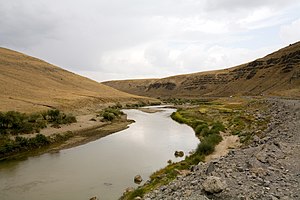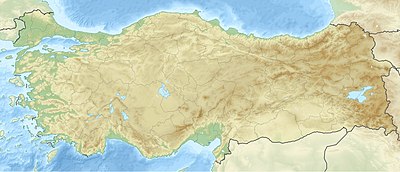geo.wikisort.org - River
The Murat River, also called Eastern Euphrates (Turkish: Murat Nehri, Kurdish: Çemê Muradê, Armenian: Արածանի, romanized: Aratsani), is a major source of the Euphrates River. The Ancient Greeks and Romans used to call the river Arsanias (Greek: Ἀρσανίας). It originates near Mount Ararat north of Lake Van, in Eastern Turkey, and flows westward for 722 km (449 mi) through mountainous area. Before the construction of the Keban Dam, the Murat River joined the Karasu River or Western Euphrates 10 km (6.2 mi) north of the dam site and 13 km (8.1 mi) north of the town of Keban.[1]
| Murat River Eastern Euphrates | |
|---|---|
 Murat River | |
| Location | |
| Country | Turkey |
| Geographical region | Armenian highlands |
| Political region | Eastern Anatolia Region |
| Physical characteristics | |
| Source | |
| • location | near Mount Ararat north of Lake Van |
| • elevation | 2,720 m (8,920 ft) |
| Mouth | |
• location | Karasu near Keban, Elazığ Province |
• elevation | 820 m (2,690 ft) |
| Length | 722 km (449 mi) |
| Basin features | |
| River system | Euphrates |
In Muş Province, the river is interrupted by the Alpaslan-1 Dam, which was completed in 2009. The Alpaslan-2 Dam was completed in 2021[2] and is located downstream of Alpaslan-1. The river merges into the reservoir of the Keban Dam, at one time Turkey's largest dam, which was completed in 1974 and provides electrical power.[3]
In Bingöl and Elazığ provinces, Kalehan Energy has four dams planned for the river: from upstream to downstream, the Upper Kaleköy Dam, Lower Kaleköy Dam, Beyhan I Dam, and Beyhan II Dam. The Beyhan I and Upper Kaleköy dams are already completed. Once completed, all four dams will have a combined installed capacity of 1,855 MW.[4]
Origin of the river name
The present name is usually connected with the Turkish Murat or its appellative murat "purpose, intention, desire". But this may be folk etymology, so Hrach Martirosyan tentatively proposes derivation from Old Armenian mōrat, murat “mud, marsh”.[5]
The river was called Arșania in sources of the Neo-Assyrian Empire, and Arsanias in Classical Greek and Roman times. Those forms may be derived from an Armenian original (Արածանի Aratsani), itself from an Indo-European root for 'white, bright'.[6][7]
Footnotes
- "Soccer On Frozen River". Turkish Daily News. 2004-12-31.
- "ENERGO-PRO commissions 280-MW Alpaslan 2 hydropower plant in Turkey". 28 April 2021.
- "Marat River". Encyclopædia Britannica. Retrieved 2008-02-16.
- "Murat Hydropower Cascade" (PDF). Poyry. Archived from the original (PDF) on 8 March 2016. Retrieved 3 March 2016.
- Hrach Martirosyan, Armenian mawr ‘mud, marsh’ and its hydronimical value, Aramazd: Armenian journal of Near Eastern studies, vol. 4.1, pp. 73–85 and 179–180 (Summary in Armenian) (2009)
- Journal of the Society for Armenian Studies. The Society. 2005. p. 33.
- Mario Liverani (1995). Neo-Assyrian geography. Università di Roma, Dipartimento di scienze storiche, archeologiche e antropologiche dell'Antichità. p. 57.
На других языках
[de] Murat (Fluss)
Der Murat (türkisch Murat Nehri, auch Murat Suyu oder Murat Irmağı; kurdisch Çemê Miradê, armenisch Արածանի (Aratsani); assyrisch Arsania, antik Arsanias[2]), auch Östlicher Euphrat, ist ein Fluss in der östlichen Türkei.- [en] Murat River
[es] Río Murat
El río Murat o Murat Su (en turco, Murat Nehri, o Murat Suyu o Murat Irmağı; en armenio, Արածանի[2]), conocido en la antigüedad como Arsanias o Aratsani, es un largo río de Turquía, una de las dos fuentes —con el río Kara Su— que con su confluencia dan lugar al nacimiento del río Éufrates. Tiene una longitud de 720 km,[3] aunque si se considera como la fuente más lejana del Éufrates —el río Karasu, aunque más corto, es considerado el verdadero Éufrates[3]— el sistema fluvial Murat–Éufrates–Shatt al-Arab llega a los 3219 km (720+2289+200 km), convirtiéndose en uno de los 25 ríos más largos del mundo y de los 10 más largos de Asia.[4][it] Murat (fiume)
Il fiume Murat (in lingua turca: Murat Nehri) è la sorgente maggiore dell'Eufrate. Nell'antichità venne anche chiamato Arsanias (in armeno: Արածանի). Il fiume nasce nei pressi del Monte Ararat a nord del lago di Van, nella Turchia orientale, e scorre verso ovest per 722 km attraverso le montagne, venendo poi a formare insieme al Karasu Çayi il corso superiore dell'Eufrate vicino Malatya. Nei suoi pressi sorgeva l'antica città di Artaxata, secondo lo storico greco Plutarco.[1][ru] Мурат (река)
Мура́т (тур. Murat Nehri, Мурад, Восточный Евфрат, Арацани — арм. Արածանի) — река, протекающая по Армянскому нагорью в Турции, важнейший приток Евфрата.Другой контент может иметь иную лицензию. Перед использованием материалов сайта WikiSort.org внимательно изучите правила лицензирования конкретных элементов наполнения сайта.
WikiSort.org - проект по пересортировке и дополнению контента Википедии
